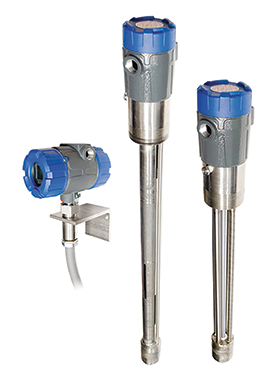

The Genesis Model ED1 emulsion detector from Magnetrol is a time domain reflectometry (TDR)-based, 24 V DC level detector designed to accurately measure the various layers in interface level measurement applications. Utilising patented top-down and bottom-up signals, along with advanced level detection algorithms, this single device can be used in a wide variety of interface applications ranging from very light hydrocarbons to water-based media.
This detector, like other Magnetrol devices, is designed to maximise ease of wiring, configuration and viewing of the versatile graphic LCD display. It supports both the Field Device Integration (FDI) and Enhanced DDL (EDDL) standards, which allow viewing of valuable configuration and diagnostic information such as the echo curve in tools such as PACTware, AMS Device Manager and various HART field communicators.
Most process, separator or storage vessels up to the rated probe temperature and pressure are supported for all interface measurement and control applications including those with process conditions exhibiting visible vapours, foam, surface agitation, bubbling or boiling, high fill/empty rates, and varying dielectric media or specific gravity.
The device sports four 4-20 mA outputs for convenient control of top level, top of emulsion, water level and sediment. A four-button keypad and graphic LCD allow for convenient viewing of configuration parameters and echo curves. Proactive diagnostics advise not only what is wrong, but also offer troubleshooting tips.
Probe designs up to +200°C/70 bar are available, and the main electronics can be mounted remotely up to 30 m away from the probe.
Principle of operation
The Genesis Model ED1 is a multiphase level detector based upon the technology of time domain reflectometry. It utilises pulses of electromagnetic energy transmitted along a physical probe. From a top-down perspective, when a pulse reaches a surface that has a higher dielectric constant than air, a portion of the pulse is reflected. The time of flight of the pulse is then measured via high-speed timing circuitry that provides an accurate measure of the liquid level. The amplitude of the reflection depends on the dielectric constant of the product, with a higher dielectric constant yielding a larger reflection.
In addition to sending high-frequency energy down the probe to detect upper (or total) level, the Genesis Model ED1 sends energy up the probe to detect various other levels that may be present; including the top of an emulsion layer, bottom of an emulsion layer (water level) and sediment.
This innovative form of TDR-based measurement, combining top-down and bottom-up signal processing utilising sophisticated and patented algorithms, makes multiphase level detection possible.
Genesis probe overview
The coaxial probe is the most efficient of all TDR probe configurations and should be the first consideration in all applications. Analogous to the efficiency of coaxial cable, a coaxial probe allows almost unimpeded movement of the high-frequency pulses throughout its length.
The electromagnetic field that develops between the inner rod and outer tube is completely contained and uniform down the entire length of the probe. This means that the coaxial probe is immune to any proximity effects from other objects in the vessel, and therefore, in essence, it can be used anywhere that it can mechanically fit.
The efficiency and overall sensitivity of a coaxial configuration yields robust signal strength, even in extremely low-dielectric applications. The sensitivity of this ‘closed’ design, however, also makes it more susceptible to measurement error in applications that can have coating and build-up.
Two styles of Genesis probes
As is typical for most level measurement technologies, choosing the proper sensing element is the most important aspect in the decision-making process. The probe configuration establishes fundamental performance characteristics.
Although both of the probes offered with the Genesis Model ED1 can be considered as coaxial, each has specific strengths and weaknesses. While there can be overlap, and both probes can certainly be used in similar applications, it is important to understand their basic differences so that one can choose the probe type that will offer optimal performance.
Enlarged coaxial
The standard coaxial offering for the Genesis Model ED1 is an enlarged 45 mm diameter probe that can generally be used for most clean applications.
5-conductor Pentarod
With a PFA-coated active centre rod surrounded by four reference rods, the 5-conductor Pentarod probe is an alternative probe offering for the Genesis Model ED1. Although this probe still yields coaxial-like performance, its open design makes it less susceptible to build-up and bridging.
Although most of the electromagnetic field develops between the centre conductor and four reference rods, there is also some peripheral energy that expands outward, making the 5-conductor probe slightly more sensitive to proximity effects of objects located immediately around it. For that reason, it is recommended to keep the active element of the 5-conductor probe at least 25 mm away from metal objects.
Optional flushing connection
The maintenance of probes in applications containing build-up or crystallisation can be improved significantly by using an optional flushing connection. This flushing connection, which is available with both probe styles, is a metal extension with a port welded above the process connection. The port allows the user to purge the inside of the probes during routine maintenance.
| Tel: | +27 11 397 1105 |
| Email: | [email protected] |
| www: | www.oihcontrols.co.za |
| Articles: | More information and articles about Oakleaf Investment Holdings 52 (OIH) |

© Technews Publishing (Pty) Ltd | All Rights Reserved